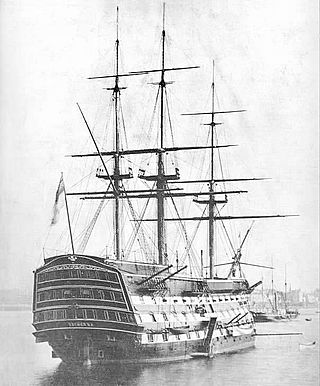
In the rating system of the British Royal Navy used to categorise sailing warships, a first rate was the designation for the largest ships of the line. Originating in the Jacobean era with the designation of Ships Royal capable of carrying at least 400 men, the size and establishment of first-rates evolved over the following 250 years to eventually denote ships of the line carrying at least 80 guns across three gundecks. By the end of the eighteenth century, a first-rate carried no fewer than 100 guns and more than 850 crew, and had a measurement (burthen) tonnage of some 2,000 tons.
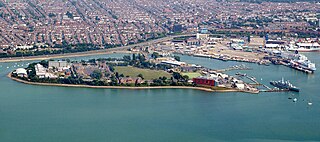
HMS Excellent is a Royal Navy "stone frigate" sited on Whale Island near Portsmouth in Hampshire. HMS Excellent is itself part of the Maritime Warfare School, with a headquarters at HMS Collingwood, although a number of lodger units are resident within the site, the principal of which is the headquarters of Fleet Commander.
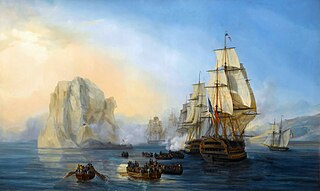
A stone frigate is a naval establishment on land.

HMS St Lawrence was a 102-gun first-rate wooden warship of the Royal Navy that served on Lake Ontario during the War of 1812. Built on the lake at the Royal Navy dockyard in Kingston, Ontario, she was the only Royal Navy ship of the line ever to be launched and operated entirely in fresh water. Constructed in 1814, the ship's arrival on the lake ended all naval action and St Lawrence finished the war having never gone into battle. Following the war, the vessel was laid up, eventually being sold in 1832 to private interests. The ship was later sunk and is now a recreational dive spot.
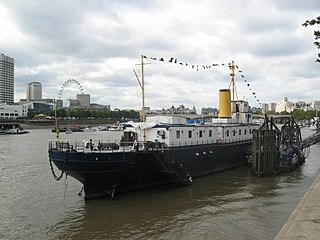
HMS President is a retired Flower-class Q-ship that was launched in 1918. She was renamed HMS President in 1922 and moored permanently on the Thames as a Royal Navy Reserve drill ship. In 1982 she was sold to private owners and, having changed hands twice, served as a venue for conferences and functions as well as the offices for a number of media companies. She has been moved to Chatham on the Medway in Kent since 2016, but is due to return to the capital. She had the suffix "(1918)" added to her name in order to distinguish her from HMS President, the Royal Naval Reserve base in St Katharine Docks. She is one of the last three surviving Royal Navy warships of the First World War. She is also the sole representative of the first type of purpose built anti-submarine vessels, and is the ancestor of World War II convoy escort sloops, which evolved into modern anti-submarine frigates.
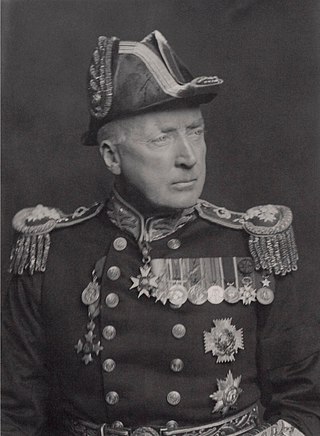
Admiral Sir Frederic Charles Dreyer, was an officer of the Royal Navy. A gunnery expert, he developed a fire control system for British warships, and served as flag captain to Admiral Sir John Jellicoe at the Battle of Jutland. He retired with the rank of admiral in 1943, having served through two world wars and having already retired once.

HMS Collingwood is a stone frigate of the Royal Navy, in Fareham, England. It is the lead establishment of the Maritime Warfare School and the largest naval training organisation in Western Europe. The Maritime Warfare School is a federated training establishment incorporating HMS Excellent, the Defence Diving School, the RN Physical Training School, the School of Hydrography and Meteorology in Plymouth and the Royal Marines School of Music in Portsmouth Naval Base.
Five ships and a shore establishment of the Royal Navy have borne the name HMS Cambridge, after the English town of Cambridge or after one of the Dukes of Cambridge:

HMS Windsor Castle was a triple-decker, 102-gun first-rate Royal Navy ship of the line. She was renamed HMS Cambridge in 1869, when she replaced a ship of the same name as gunnery ship off Plymouth.
Four ships and three shore establishments of the Royal Navy have been named HMS Sultan.

HMS Calcutta was an 84-gun second-rate ship-of-the-line of the Royal Navy, built in teak to a draught by Sir Robert Seppings and launched on 14 March 1831 in Bombay. She was the only ship ever built to her draught. She carried her complement of smooth-bore, muzzle-loading guns on two gundecks. Her complement was 720 men.

Eighteen ships of the Royal Navy have borne the name HMS Mercury, or HMS Mercure, after the God Mercury, of Roman mythology:
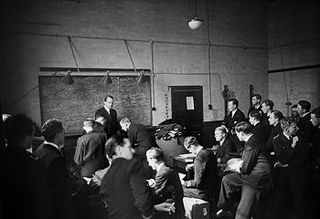
HMS Vernon was a shore establishment or "stone frigate" of the Royal Navy in Portsmouth. Vernon was established on 26 April 1876 as the Royal Navy's Torpedo Branch also known as the Torpedo School, named after the ship HMS Vernon which served as part of its floating base. After the First World War, HMS Vernon moved ashore, taking over the Gunwharf site, where it continued to operate until 1 April 1996, when the various elements comprising the establishment were split up and moved to different commands.

Major Francis John William Harvey, VC was an officer of the British Royal Marine Light Infantry during the First World War. Harvey was posthumously awarded the Victoria Cross, the highest military award for gallantry in the face of the enemy given to British and Commonwealth forces, for his actions at the height of the Battle of Jutland. A long-serving Royal Marine officer descended of a military family, during his career Harvey became a specialist in naval artillery, serving on many large warships as gunnery training officer and gun commander. Specially requested for HMS Lion, the flagship of the British battlecruiser fleet, Harvey fought at the battles of Heligoland Bight, Dogger Bank and Jutland.
Two ships and a training establishment of the Royal Navy have borne the name HMS Vernon, possibly after Admiral Edward Vernon:
A ship and a shore establishment of the Royal Navy have borne the name HMS Excellent:

HMS Ganges was a training ship and later stone frigate of the Royal Navy. She was established as a boys' training establishment in 1865, and was based aboard a number of hulks before moving ashore. She was based alternately in Falmouth, Harwich and Shotley. She remained in service at RNTE Shotley until October 1976.
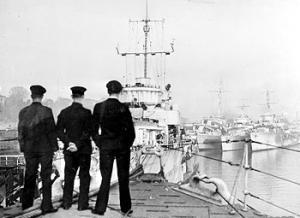
HMS Ferret was a shore establishment and naval base of the Royal Navy during the Second World War, located in Derry. It was given a ship's name as a stone frigate.

The Gunnery Division was a Directorate of the Admiralty Naval Staff of the Royal Navy responsible for the tactical use of naval weapons and the training of naval personnel in relation to operational requirements. It was established in 1920 when the Gunnery and Torpedo Division was separated into an independent Gunnery Division and Torpedo Division. It existed until 1964 when the Department of Admiralty was abolished and replaced by a new Ministry of Defence.















